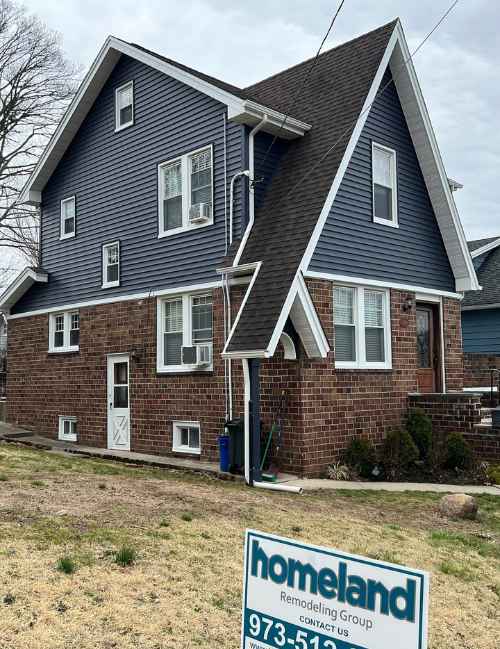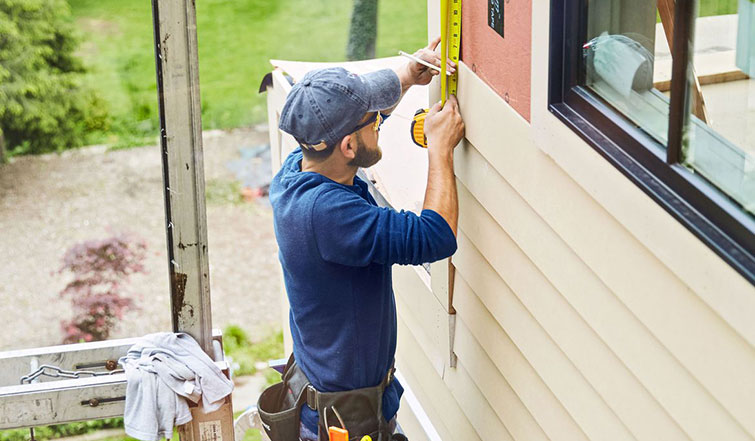The Crucial Guide to the Various Kinds of Exterior Siding and Their Unique Advantages
In the world of home renovation, picking the ideal house siding is a crucial decision that impacts both aesthetic appeal and useful efficiency. With so lots of choices to think about, which home siding product genuinely stands out for your details job?
Timber House Siding
Timber house siding, a preferred selection for residential exteriors, offers a timeless visual that incorporates all-natural beauty with structural integrity. This house siding product is offered in various designs, consisting of clapboard, roof shingles, and board-and-batten, allowing homeowners to customize their façade to match their design choices. Timber house siding is typically crafted from sturdy varieties such as cedar, redwood, or want, which are understood for their durability and ability to hold up against environmental stress factors.
Among the key advantages of wood siding is its exceptional insulation residential or commercial properties, which can add to energy performance and lower heating prices. Furthermore, timber exterior siding is eco-friendly, making it an eco-friendly option when sourced sustainably. Routine upkeep, including painting or discoloration, can prolong its life expectancy and boost its appearance, enabling home owners to protect the all-natural charm of the wood.
Nonetheless, potential disadvantages consist of vulnerability to pests, rot, and weather condition damage, requiring adequate therapy and maintenance - morris siding contractor. Regardless of these issues, when correctly taken care of, wood siding can give a resilient and gorgeous service that improves the personality of a home while offering a warm, inviting environment

Plastic Siding
Plastic house siding has actually become a leading option for property owners seeking a low-maintenance exterior choice that integrates durability and price. This flexible product is crafted from polyvinyl chloride (PVC), making it resistant to various weather, consisting of moisture and UV rays. Consequently, vinyl house siding does not warp, rot, or fade, ensuring long-lasting aesthetic allure.
One of the primary advantages of vinyl siding is its considerable series of designs and shades, enabling property owners to achieve the desired appearance for their property without the demand for constant repainting. In addition, vinyl exterior siding is simple to set up, which can considerably reduce labor prices throughout construction or improvement jobs.
Plastic siding likewise contributes to power performance. Several options feature insulation backing, which enhances thermal efficiency, aiding to keep comfortable indoor temperatures and potentially lowering energy expenses. Its smooth surface helps with simple cleansing, needing only periodic washing with a garden hose to remove dirt and debris.
Fiber Cement Home Siding
Fiber concrete exterior siding has gotten grip amongst home builders and homeowners alike due to its exceptional mix of toughness and visual versatility. Composed of a combination of cellulose, concrete, and sand fibers, this house siding alternative is crafted to withstand extreme climate condition, consisting of high winds, hefty rain, and temperature level variations, making it a long-lasting choice for household outsides.

One of the key benefits of fiber concrete siding is its resistance to pests, such as termites, and its non-combustible nature, offering improved fire safety. morris siding contractor. Additionally, it is available in a wide array of appearances, shades, and styles, permitting house owners to attain their wanted visual without compromising performance
Another benefit is its low upkeep needs; fiber cement house siding generally needs painting or discoloration every 5-10 years, which is much less constant than various other materials. Its longevity contributes to a lower general expense of possession, as it minimizes the demand for constant repairs or replacements.
Ultimately, fiber cement home siding represents an exceptional financial investment for those looking for a resilient, attractive, and versatile exterior choice, integrating both kind and function to enhance the home's visual charm.
Steel Exterior Siding
The attraction of steel house siding lies try this web-site in its robust durability and contemporary aesthetic allure, making it a preferred choice for contemporary style. Offered in products such as aluminum and steel, steel siding uses an array of shades and coatings, permitting home owners to attain a tailored look that matches their layout vision.

Power performance is another considerable benefit, as several metal exterior siding items are created with insulation alternatives that aid manage interior temperature levels. This can bring about lowered power prices gradually. Additionally, metal home siding is often recyclable, making it an eco-friendly selection for sustainability-minded home owners.
The installment procedure for metal exterior siding can be relatively straightforward, leading to a quicker turn-around time for building and construction projects. In general, steel exterior siding combines functionality and design, making it a functional option for those looking for a aesthetically appealing and long-lasting outside finish.
Block and Stone Siding
Block and stone siding attracts attention as an ageless choice that boosts the aesthetic beauty of any type of home. Known for their durability and reduced maintenance, these products offer an outstanding return on investment while boosting the property's visual appeal. Offered in various colors, textures, and patterns, brick and rock can be tailored to suit diverse building styles, from typical to contemporary.
Among the primary advantages of block and stone home siding is their power efficiency. Both materials have all-natural protecting homes that help control interior temperature levels, potentially reducing heating and air conditioning costs. Furthermore, they use superior fire resistance compared to various other house siding options, contributing to improved security.
Another benefit is their long life. Brick and stone can last for years, usually requiring minimal upkeep past periodic cleaning. Unlike timber siding, they are impervious to bugs and rot, making sure a durable outside that withstands the aspects.
Verdict
In recap, the selection of home siding considerably impacts a home's visual appeal, power efficiency, and upkeep requirements. Each kind of exterior siding-- whether timber, vinyl, fiber concrete, brick, or steel and stone-- uses unique advantages customized to different home owner preferences and ecological conditions.
One of the main see this advantages of wood home siding is its superb insulation properties, which can contribute to power efficiency and lower home heating prices. Additionally, timber siding is naturally degradable, making it an eco pleasant option when sourced sustainably.One of the main advantages of steel siding is its resistance to different ecological variables.Energy efficiency is one more substantial benefit, as many metal home siding items are made with insulation options that help control interior temperature levels. Each kind Continue of house siding-- whether timber, vinyl, fiber cement, brick, or metal and stone-- offers distinct benefits tailored to different homeowner choices and environmental conditions.